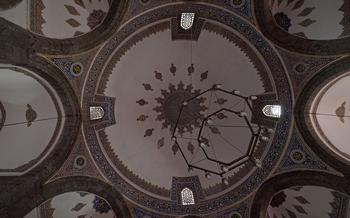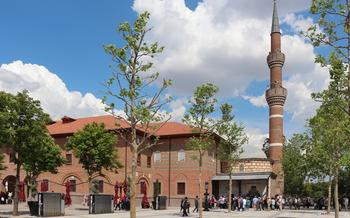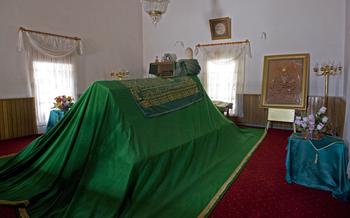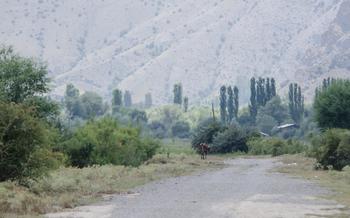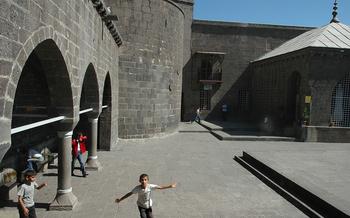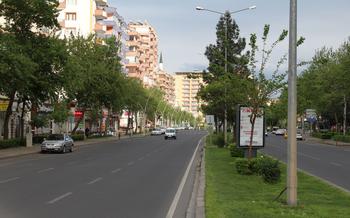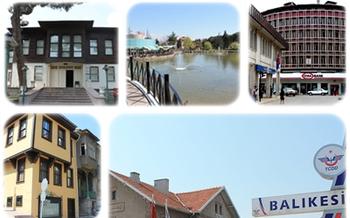
Diyarbakır Mevlana Halid Mosque
- Diyarbakır Mevlana Halid Mosque: A Spiritual Haven in the Heart of Turkey
- Unveiling the Rich History of the Mosque
- Exploring the Unique Architectural Features
- Discover the Spiritual Significance
- Understanding the Cultural and Religious Context
- Historical Significance: A Journey Through Time
- Architectural Marvel: A Masterpiece of Islamic Design
- Spiritual Significance: A Place of Worship and Contemplation
- Cultural and Religious Context: A Reflection of Anatolian Heritage
- Visiting the Mosque: A Guide for Travelers
- Unveiling the Interior: A Realm of Beauty and Grandeur
- The Minaret: A Symbol of Divine Guidance
- The Prayer Hall: A Sacred Space for Worship
- The Minbar: A Platform for Guidance and Wisdom
- The Qibla Wall: A Symbol of Unity and Direction
- The Dome: A Symbol of Heaven and Divine Protection
- Insider Tip: Unveiling Hidden Gems
Diyarbakır Mevlana Halid Mosque: A Spiritual Haven in the Heart of Turkey
The Diyarbakır Mevlana Halid Mosque stands as a testament to the rich history, architectural prowess, spiritual significance, and cultural tapestry of Turkey. Built in the 13th century, this awe-inspiring mosque has witnessed centuries of devotion, serving as a sanctuary for spiritual seekers and a symbol of religious harmony in the heart of Anatolia.
Unveiling the Rich History of the Mosque
The Diyarbakır Mevlana Halid Mosque owes its existence to the vision of Mevlana Halid, a renowned Islamic scholar and spiritual leader. Guided by his profound knowledge and unwavering faith, Mevlana Halid laid the foundation of this magnificent mosque, hoping to create a sacred space that would foster spiritual growth and community unity.
Exploring the Unique Architectural Features
The Diyarbakır Mevlana Halid Mosque boasts a distinctive architectural style that blends traditional Islamic elements with Anatolian influences. Its intricate tilework, elegant calligraphy, and soaring minaret showcase the mastery of skilled artisans and craftsmen who dedicated their lives to beautifying this house of worship.
Discover the Spiritual Significance
As a place of worship, the Diyarbakır Mevlana Halid Mosque holds immense spiritual significance for Muslims in the region. It serves as a sanctuary for prayer, contemplation, and connection with the divine. The mosque's serene atmosphere and beautiful interior create an environment that encourages spiritual reflection and growth.
Understanding the Cultural and Religious Context
The Diyarbakır Mevlana Halid Mosque stands as a symbol of religious tolerance and harmony in Turkey. It reflects the rich cultural heritage of Anatolia, where different faiths and traditions have coexisted for centuries. The mosque's presence in the heart of Diyarbakır underscores the city's commitment to preserving its diverse cultural and religious identity.
Historical Significance: A Journey Through Time
The Diyarbakır Mevlana Halid Mosque holds immense historical significance, deeply rooted in the city's rich past. Its origins can be traced back to the 16th century, when the renowned Islamic scholar and Sufi mystic, Mevlana Halid-i Bağdadi, embarked on a mission to spread his teachings in the region. Inspired by his vision, the mosque was constructed as a center for Islamic learning and spirituality. Over the centuries, the mosque has undergone several renovations and expansions, reflecting the evolving needs of the community and the enduring legacy of Mevlana Halid-i Bağdadi's teachings.
The mosque's construction was not without challenges. In the 18th century, a devastating earthquake struck Diyarbakır, causing significant damage to the mosque. However, the community rallied together to rebuild and restore the mosque to its former glory. This resilience and dedication are a testament to the mosque's profound importance to the people of Diyarbakır.
Throughout history, the Diyarbakır Mevlana Halid Mosque has played a pivotal role in the religious and cultural life of the city. It has served as a gathering place for scholars, students, and worshippers, fostering a vibrant intellectual and spiritual environment. The mosque's influence extends beyond Diyarbakır, attracting pilgrims and visitors from across the region who seek spiritual guidance and inspiration.
Architectural Marvel: A Masterpiece of Islamic Design
The Diyarbakır Mevlana Halid Mosque stands as a testament to the architectural prowess of Islamic design. Its unique style, characterized by a harmonious blend of Anatolian and Seljuk influences, captivates the eyes of visitors. The exterior façade is adorned with intricate carvings and calligraphy, while the interior boasts a stunning display of tilework and geometric patterns. Each element of the mosque's architecture carries deep symbolic meaning, reflecting the spiritual and cultural significance of the building.
The mosque's central dome, a symbol of heaven and divine protection, dominates the skyline and is visible from afar. Its intricate patterns and vibrant colors create a mesmerizing effect, drawing visitors closer to marvel at its grandeur. The minaret, a symbol of divine guidance, rises gracefully beside the dome and offers stunning views of the surrounding landscape. Its intricate carvings and delicate proportions exemplify the architectural mastery of the mosque's builders.
The courtyard, a place of tranquility and reflection, features a beautifully designed ablution fountain, inviting visitors to purify themselves before entering the prayer hall. The surrounding gardens and landscaping add to the serene atmosphere, creating a sense of peace and tranquility that envelops the entire mosque complex.
Spiritual Significance: A Place of Worship and Contemplation
The Diyarbakır Mevlana Halid Mosque is not just an architectural marvel; it is also a place of immense spiritual significance. For centuries, it has been a place of worship and contemplation for Muslims in Diyarbakır and beyond. The mosque's serene atmosphere and beautiful interior create a conducive environment for spiritual reflection and prayer.
The mosque holds a special place in the hearts of the local community. Muslims from all walks of life gather here to offer their prayers and connect with their faith. The mosque's traditions and rituals are deeply rooted in Islamic teachings, and visitors can observe the vibrant spiritual life of the community firsthand.
The mosque's tranquility and spiritual aura are palpable. Visitors can find solace and peace within its walls, away from the hustle and bustle of everyday life. It is a place where one can come to reconnect with oneself, reflect on life's deeper meanings, and seek divine guidance.
The Diyarbakır Mevlana Halid Mosque is a living testament to the power of faith and spirituality. It stands as a beacon of hope and guidance for the Muslim community, offering a sacred space for worship, contemplation, and spiritual growth.
Cultural and Religious Context: A Reflection of Anatolian Heritage
The Diyarbakır Mevlana Halid Mosque is deeply ingrained in the cultural fabric of Turkey, serving as a testament to the rich blend of Islamic and Anatolian influences. The mosque embodies the harmonious coexistence of diverse religious communities, showcasing the region's long history of tolerance and mutual respect.
As a symbol of Islamic faith, the mosque stands as a beacon of spirituality for the Muslim community in Diyarbakır. It serves as a central gathering place for worship, prayer, and religious ceremonies, fostering a sense of unity and belonging among the faithful. The mosque's architectural design and sacred spaces reflect Islamic principles and traditions, creating an environment conducive to contemplation and spiritual introspection.
Beyond its religious significance, the mosque also holds cultural and historical value. It represents the convergence of Islamic architectural styles with Anatolian craftsmanship and artistry. The intricate tilework, calligraphy, and decorative elements showcase the region's rich cultural heritage and the blending of artistic influences throughout history.
The mosque's location in the heart of Diyarbakır serves as a reminder of the city's historical role as a crossroads of cultures and civilizations. It stands as a testament to the region's enduring traditions, customs, and beliefs, showcasing the harmonious coexistence of different ethnic groups and religious communities throughout history.
Whether viewed through the lens of faith, culture, or history, the Diyarbakır Mevlana Halid Mosque stands as a symbol of Anatolian heritage, embodying the region's spiritual, cultural, and historical significance.
Visiting the Mosque: A Guide for Travelers
Before embarking on your journey to the Diyarbakır Mevlana Halid Mosque, it is important to be aware of the visiting hours and dress code. The mosque is open to visitors of all faiths during specific hours throughout the day. It is customary to dress modestly and respectfully when visiting a mosque, so avoid wearing shorts, tank tops, or revealing clothing. Upon entering the mosque, remember to remove your shoes and place them on the designated shelves.
To truly appreciate the mosque's spiritual essence, it is recommended to visit during the early morning or late afternoon when the sunlight casts a beautiful glow on the intricate details and creates a serene atmosphere. While inside the mosque, maintain a respectful demeanor and avoid loud conversations or disruptive behavior. Follow the signs and designated pathways to ensure a smooth and respectful visit.
After exploring the mosque's interior, take some time to wander around the courtyard and admire the surrounding gardens. The courtyard offers a peaceful retreat where you can reflect on your visit and soak in the tranquility of the mosque's surroundings. Before departing, don't forget to capture some stunning photographs of the mosque's exterior, ensuring that you have lasting memories of your visit to this architectural marvel.
Unveiling the Interior: A Realm of Beauty and Grandeur
As you step inside the Diyarbakır Mevlana Halid Mosque, prepare to be mesmerized by its breathtaking interior. The awe-inspiring main prayer hall is a testament to the mosque's architectural prowess. Its vast space is punctuated by rows of elegant columns, each adorned with intricate carvings and calligraphy. The walls are adorned with vibrant tilework, depicting intricate geometric patterns and floral motifs in shades of blue, green, and gold. The ceiling is a masterpiece in itself, adorned with a magnificent dome that seems to float effortlessly overhead. The dome's interior is adorned with intricate paintings and Quranic verses, creating a sense of divine grandeur. The mosque's chandeliers, suspended from the ceiling, add a touch of opulence and illuminate the space with a warm, inviting glow. Every corner of the mosque's interior reveals a new treasure, a testament to the artistry and devotion of its creators.
The Minaret: A Symbol of Divine Guidance
The Diyarbakır Mevlana Halid Mosque's minaret, a striking architectural element, stands tall, piercing the sky with its celestial allure. Its cylindrical form, adorned with intricate carvings and decorative bands, exemplifies the exquisite craftsmanship that characterizes Islamic architecture. The minaret's slender structure tapers gracefully towards the heavens, symbolizing the unwavering connection between the earthly realm and the divine.
The minaret's primary function is to serve as a platform for the muezzin, who calls the faithful to prayer with their melodic chants. The muezzin's voice reverberates through the air, echoing across the city, inviting the community to come together in worship and devotion. The minaret's strategic placement ensures that the call to prayer reaches every corner of Diyarbakır, reminding the faithful of their spiritual obligations amidst the bustling cityscape.
Ascending the minaret's winding staircase is a unique experience, offering visitors breathtaking panoramic views of Diyarbakır's rich tapestry of history and culture. The city's ancient walls, historic landmarks, and vibrant neighborhoods unfold before your eyes, creating a mesmerizing vista that captivates the senses. The climb to the top of the minaret is both physically and spiritually rewarding, as it allows visitors to experience the mosque from a different perspective and gain a deeper appreciation for its architectural grandeur.
The Prayer Hall: A Sacred Space for Worship
The prayer hall of the Diyarbakır Mevlana Halid Mosque is a breathtaking spectacle, showcasing the grandeur and devotion that lie at the heart of this sacred space. As you step into the hall, you are enveloped by a sense of awe and tranquility, the air thick with the whispers of prayers and supplications. The vast expanse of the prayer hall is adorned with intricate designs and decorations, each element carefully crafted to create a harmonious and inspiring environment for worship.
The walls are adorned with verses from the Quran, inscribed in elegant calligraphy that dances across the surface like a graceful melody. The ceiling, a masterpiece of Islamic architecture, is a symphony of domes and arches, each adorned with intricate patterns and vibrant colors that draw the eye upwards, inviting the faithful to contemplate the heavens.
The mihrab, the focal point of the prayer hall, is a sight to behold. This sacred niche, which indicates the direction of Mecca, is adorned with exquisite tilework and intricate carvings, each detail symbolizing the profound reverence and devotion that permeate this sacred space. The minbar, a raised platform from which the imam delivers sermons, is another masterpiece of craftsmanship, its intricate carvings and elegant design adding to the overall grandeur of the prayer hall.
As the faithful gather in the prayer hall, their voices rise in unison, filling the air with a harmonious recitation of verses from the Quran. The atmosphere is electric, charged with devotion and a sense of unity that transcends all boundaries. Here, in this sacred space, the faithful find solace, guidance, and a connection to the divine that nourishes their souls and strengthens their faith.
The Minbar: A Platform for Guidance and Wisdom
The minbar, a prominent feature within the Diyarbakır Mevlana Halid Mosque, stands as a symbol of guidance and wisdom, inviting worshippers to seek knowledge and spiritual enlightenment. Crafted from intricately carved wood, the minbar showcases exquisite craftsmanship, adorned with delicate patterns and motifs that reflect the rich Islamic tradition. Its elevated platform signifies the authority and respect accorded to the imam, who delivers sermons and religious teachings from this sacred space.
The minbar's design incorporates several unique elements that enhance its visual appeal and functionality. The staircase, leading to the platform, features intricate carvings and decorative balustrades, providing a sense of grandeur and elegance. The upper section of the minbar is adorned with a canopy, supported by slender columns and arches, creating a sense of enclosure and reverence. The intricate latticework and calligraphy that adorn the canopy further enhance the minbar's beauty, transforming it into a masterpiece of Islamic art.
Beyond its aesthetic significance, the minbar holds deep spiritual and cultural meaning for the Muslim community. It serves as a platform for the imam to deliver sermons, providing guidance and inspiration to the faithful. Through the teachings imparted from the minbar, worshippers gain insights into the Quran, the Sunnah, and Islamic jurisprudence, fostering a deeper understanding of their faith.
Whether admiring its intricate craftsmanship, contemplating its spiritual significance, or listening to the imam's words of wisdom, the minbar within the Diyarbakır Mevlana Halid Mosque stands as a testament to the enduring legacy of Islamic architecture and its profound impact on the lives of believers.
The Qibla Wall: A Symbol of Unity and Direction
The qibla wall, also known as the mihrab wall, holds a significant position within the Diyarbakır Mevlana Halid Mosque. This wall serves as a guiding element for worshippers, indicating the direction of Mecca, the holiest city in Islam. Constructed with meticulous precision, the qibla wall features a series of intricate niches and decorative elements that enhance its sacred status.
In Islamic architecture, the qibla wall represents the unity and direction of the Muslim community. It serves as a reminder of the shared spiritual connection among believers, regardless of their geographical location. The wall's alignment with Mecca symbolizes the collective orientation towards the Kaaba, the central and most sacred site in Islam.
The qibla wall at the Diyarbakır Mevlana Halid Mosque stands as a testament to the mosque's adherence to Islamic traditions. Its intricate design and symbolic significance contribute to the overall spiritual atmosphere of the mosque, creating a sense of harmony and devotion among worshippers.
The Dome: A Symbol of Heaven and Divine Protection
The majestic dome of the Diyarbakır Mevlana Halid Mosque stands as a testament to the architectural prowess of its builders. Soaring high above the city skyline, the dome is a symbol of heaven and divine protection, inviting the faithful to seek solace and guidance within its sacred space. Constructed using traditional techniques, the dome is a masterpiece of engineering, showcasing the harmonious balance between form and function. Its intricate patterns and designs reflect the rich artistic heritage of the region, while its towering presence evokes a sense of awe and wonder in the hearts of visitors. The dome's interior is adorned with vibrant colors and intricate tilework, creating a mesmerizing spectacle that draws the eye upwards. Here, the faithful gather to offer their prayers and seek divine blessings, surrounded by the beauty and grandeur of this architectural marvel.
Insider Tip: Unveiling Hidden Gems
To truly immerse yourself in the essence of Diyarbakır Mevlana Halid Mosque and its surroundings, consider hiring a local guide. These knowledgeable individuals can provide insights into the mosque's history, architecture, and spiritual significance that you might miss on your own. They can also lead you to hidden gems within the mosque complex, such as a secluded courtyard or a rooftop terrace with breathtaking views.
After exploring the mosque, satisfy your taste buds with authentic Turkish cuisine at nearby traditional restaurants. Indulge in succulent kebabs, savory mezes, and aromatic Turkish coffee. These culinary delights will transport you to the heart of Turkish culture and provide a memorable gastronomic experience.
For photography enthusiasts, the mosque offers a wealth of opportunities to capture stunning images. Explore the intricate tilework, the graceful arches, and the towering minaret, each offering a unique perspective. Patience and creativity will reward you with exceptional photographs that will serve as lasting mementos of your visit.
My personal experience at the mosque was truly unforgettable. I was fortunate to have a local guide who shared fascinating stories about the mosque's history and significance. We discovered a hidden courtyard adorned with colorful flowers and a tranquil fountain, a serene oasis amidst the bustling city. The guide also recommended a nearby restaurant serving traditional Turkish fare, where we enjoyed a delicious meal that left us craving for more.
These insider tips will help you unlock the hidden treasures of Diyarbakır Mevlana Halid Mosque and its surroundings. Embrace the opportunity to connect with the local culture, savor authentic flavors, capture stunning visuals, and create lasting memories that will make your visit truly special.
